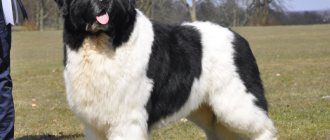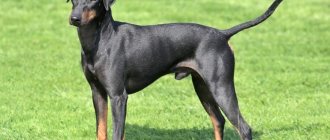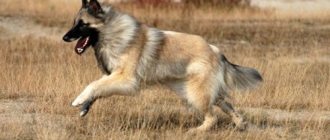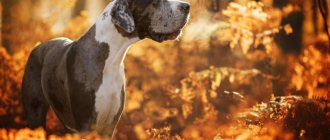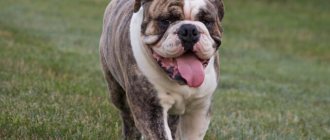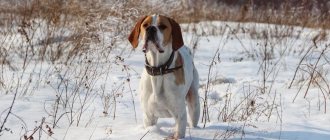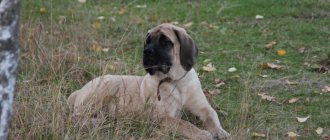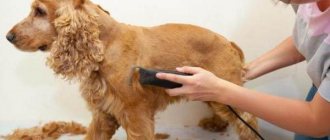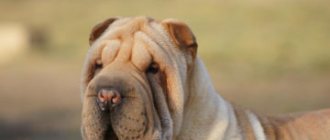Hound dogs have unique characteristics: they easily develop great speed, are distinguished by agility and a strong hunting instinct. The English Foxhound is one of the brightest representatives of the category. This is not the easiest dog to raise and maintain, but the owner’s efforts always pay off with devotion and obedience.
- 2 Description of the breed
2.1 Character and psyche of the breed - 2.2 Disadvantages and disqualifications
Dossier
Other possible names: English foxhound, parfors foxhound, English parataya hound. Adult height: 57-65 cm. Weight: 26-36 kg. Characteristic color: lemon piebald, white with black spots in blush. Coat length: short, close-lying. Life expectancy: 11-15 years. Advantages of the breed: friendly, hardy, energetic, independent, determined, gets along well with children and pets. Easily withstands exhausting jumps over rough terrain with frequent obstacles, while easily developing an average speed of 20 to 25 km/h. Difficulties of the breed: constant support of an active lifestyle. The scent of this breed is slightly weakened due to the fact that the fox, which is the main object of hunting, has a rather pungent odor. Average price: approximately from $400. Classification:
- group: hounds and related breeds;
- section: hound;
- subsection: large hound.
Appearance of the hounds
The dogs are not too tall, their height is slightly above average. Adults reach 65 cm in length. The body has a clear outline. Some dogs have slightly protruding ribs. Males and females have long powerful legs and a short tail. The hounds' muzzle is elongated and their ears droop. They have a beautiful neck and straight-set eyes. The look is clear and lively.
The pet needs to be controlled and raised very well
Hounds are quite active. Their fur is not very long. The Hanoverian breed has a long-haired coat. There are several regions in Russia where dogs of this breed are bred. As for the coloration, hounds have a variety of colors: there are tricolor speckled and crimson. The paws are powerful, the muscles are strong. The dog has large paw pads, a straight tail raised up. This breed has its own unique characteristics. Puppies are not cheap. Before adopting a baby, it is recommended to look at the pedigree and verify the authenticity of the documents.
History of the origin of the breed
The English Foxhound was first heard of in Great Britain back in the 14th century. In those days, horse hunting for foxes was especially popular, and therefore there was an urgent need for hardy and fast dogs that were ready to work in a pack. After some time, the experiment of experienced dog breeders in crossing various greyhounds and hounds was crowned with tremendous success and the hunters acquired an excellent companion.
The basis for breeding the English Foxhound or Foxhound was the ancient Celtic hounds, in particular the Talbot, which at one time inherited the elegance and speed from the influx of blood from a breed such as the Greyhound. In addition, terriers took part in the crossing, from which this animal acquired tenacity and intelligence, as well as bulldogs, which imparted their courage and strength.
It is reliably known that English Foxhounds were brought to North America in 1650, where they quickly gained fame. Moreover, in America, these dogs were used to breed the equally popular breed of American Foxhound . Europe also did not miss its chance and, based on the foxhound, created various breeds of hounds, and Russia created the Russian piebald hound.
The English Foxhound is a representative of the breed, which has the oldest pedigree book, records in which have been kept since 1786. The peak popularity of these dogs was recorded in the 19th century, when Napoleon III's pack consisted of about 120 individuals of this breed. In 1880, there were about seven thousand foxgons in England.
Over time, the fashion for hunting passed and, despite all the advantages and enormous popularity of English Foxhounds, the demand for them began to decline. However, instead of hunting, they found their calling at dog sports competitions and exhibitions, where they became regular participants and, of course, frequent winners.
In 1955, the breed was recognized by the Fédération Cynologique Internationale (FCI) and was included in the group “Hounds and Related Breeds” under number 159. Today, the largest numbers of the English Foxhound breed are registered in England and Canada.
Price
It is better to buy a Gascony hound from a kennel. The breeder provides you with a passport for the puppy, which indicates: the animal’s pedigree, its color, gender, vaccinations, etc. The cost of an animal from a nursery will be more expensive than purchasing it through an advertisement.
The price for dogs varies:
- If the animal is from a nursery, then a large breed will cost from 20 thousand rubles, a small one - from 15 thousand rubles.
- If the animal is purchased through an advertisement, then the cost of a large dog will be from 15 thousand rubles, a small one - from 10 thousand rubles.
Purpose of the breed
The Foxdog breed was originally bred for hunting; for several centuries this activity was the main and only purpose of these dogs. Animals were kept exclusively in packs, which together took an active part in baiting foxes. Sometimes English Foxhounds were used when hunting larger animals.
Over time, hunting dogs migrated from the forests to dog shows and sports rings, from pack animals they turned into domestic companions and pets. However, there are still connoisseurs of the hunting qualities of these individuals in the world, and some dogs still perform their original functions with great pleasure.
Coonhound dog health
Coonhounds in general are quite strong animals with an excellent immune system. The most common defects in raccoon dogs are hip dislocation and some eye problems. Dysplasia can be either hereditary or acquired. Genetic problems in the general population can only be solved by culling. The dogs are x-rayed and sick dogs are not allowed to be bred. Affected dogs are prescribed therapy depending on the severity of the disease. Many people have to undergo surgery. To raise a healthy dog, it must be properly maintained.
Description of the nature of the breed
- Particular attention should be paid to those qualities that are characteristic of real hunters - smart, attentive, hardy, sensitive, strong.
- Thanks to its cheerfulness and friendliness, this breed can be safely classified as a family pet. Foxcats dote on children, and they, in turn, dote on them. There is nothing more common than seeing little children playing with a foxhound. According to some parents, these dogs make excellent nannies.
- Since long life in packs is in the blood of this breed, foxcats get along well with any pets .
- These dogs are incredibly loyal and very obedient. They will be wary and distrustful of strangers until the owner convinces them otherwise. The arrival of an uninvited guest is accompanied by a ringing and loud bark.
- The English Foxhound is particularly inquisitive - it constantly tries to pick up someone's scent, and also sniffs out something all the time and sometimes sticks its nose where it shouldn't. Therefore, it is worth paying attention to him more often, especially when he is left alone.
- This dog is very energetic and active . She will be a great companion during your morning or evening jog.
- Lysogons are completely unpretentious in maintenance and food.
Diseases of the English Foxhound
English Foxhounds are considered fairly healthy dogs, with an average lifespan of 10–13 years. Common genetic diseases are:
- Hypothyroidism is decreased function of the thyroid gland. The disease can manifest itself as disturbances in any system, as the body suffers from a lack of a number of hormones. Typically, owners complain about the animal being overweight, weakness, apathy, deterioration of skin condition, and partial baldness. If hypothyroidism is diagnosed, the dog will be prescribed lifelong administration of the hormone thyroxine (replacement therapy).
- Deafness. The problems are associated with the dominance of the merle gene in foxhounds, which is responsible for the color of the coat with the presence of lighter and darker areas on it. When crossing two marbled animals, there is a high probability of genetic abnormalities, in particular deafness. A dog with such a problem cannot be cured, and its maintenance will require an exceptionally experienced owner.
- Cardiomyopathy is damage to the walls of the ventricles and atria due to degenerative processes in the muscles. The organ begins to contract weakly, which entails a drop in pressure, weakness, coughing with minimal exertion, decreased muscle mass and pallor of the mucous membranes. The disease is life-threatening for the dog, so the veterinarian must prescribe medications to prevent the death of heart tissue and improve its functioning. Treatment will be lifelong.
The English Foxhound is a hound dog that has a strong hunting instinct. She gets along well with people and relatives, but often treats small pets as prey. In a metropolis it may be difficult to keep such an animal, but in a country house it will be as comfortable as possible.
How to choose a puppy
- First of all, it is necessary to inspect the living conditions of the litter.
- Next, it’s worth assessing the mother’s appearance and asking the breeder about her state of health, as well as all kinds of hereditary diseases.
- The puppy should be well-fed (a little thick), active and strong.
- It is best to purchase a Foxhound between 1.5 and 3 months of age. It is believed that the puppy is fully strengthened closer to two months of age. Older individuals already have a formed character, which in the future can lead to difficulties during re-education.
A fox puppy has the following characteristics:
- slightly elongated body, wide skull and elongated muzzle;
- a pronounced transition from the forehead to the bridge of the nose;
- high-set, hanging ears of medium length;
- medium-sized brown eyes - a decisive and lively look;
- the paws along their entire length should have the same thickness, and the toes should be tightly closed;
- the long tail resembles a saber, as the top is sharply raised;
- The coat is thick, harsh and short, most often having a white-piebald tint or a tri-color color.
Characteristic
The Irish Terrier is a universal dog, a family favorite, a guard and an indispensable assistant to the owner. Can be a hunter and gun dog. Belongs to the terrier group, does not pass working tests.
FCI breed standard: No. 139
An active and lively dog is proportional and does not show clumsiness when moving. It has a long head with a flat, rather narrow skull and a barely noticeable stop. The muzzle is moderately wide, without narrowing. The nose is black, fully pigmented.
The Irishman's cheekbones are moderate, but his jaws are quite long and strong, providing a good grip. The teeth are straight - the upper ones are slightly pushed forward, overlapping the lower ones. Dry lips adhere tightly to the teeth line.
The eyes are small and dark in color – light or yellow are undesirable. You can read curiosity, fire and interest in life in your gaze. The infraorbital areas protrude barely noticeably. Small ears are set high on the skull, the tips hang forward, reaching to the temporal region.
The neck is dense and long, set almost vertically, there is no dewlap. The neck widens towards the shoulders, turning into strong shoulders. The back line is straight, the loin protrudes slightly, the croup is completed by a saber-shaped tail set vertically, covered with coarse hair without fringes. Some dogs have their tails docked.
The terrier's chest is dense, but not too wide, and the ribs are long. The limbs are set parallel, the hips are powerful. The hock joints of the hind legs are set low.
Breed faults:
- cowardice;
- aggression;
- under/undershot;
- depigmentation of the lobe; any shade except black;
- color deviation from those specified by the standard;
- cracks on the paw pads.
Obvious physiological or psychological deviations from the standard. Any defect leads to the exclusion of the dog from breeding.
Irish Terrier – dog photo, character description
Dimensions, weight and height of the breed
The height of the Irish Terrier is 45.5 cm, according to the standard. Minimal deviations are acceptable. Males weigh more than females - about 12.2 kg, the latter's weight is 11.4 kg.
Possible colors
The Irishman's coat is short and broken, reminiscent of twisted wire in structure. It fits so tightly to the body that even if you pull the skin apart with your hands, you won’t see the skin. The head and limbs are covered with shorter hairs, straight and smooth. There should be no curls in the coat. The maximum length of hair is on the beard and mustache of a terrier.
Color options:
- wheat with red rye;
- bright red;
- golden with a red tint.
Any color may have small white spots on the sternum.
Puppy weight by month
Irish Terrier puppies are born weighing about 225 g. They actively gain weight at the very beginning of life.
Approximate age to weight ratio:
- 1 month – 1.1 kg;
- 2 months – 2.5 kg;
- 5 months – 6 kg;
- 8 months – 9 kg;
- 11 months – 9-11 kg.
The given parameters are approximate, the weight depends on the genetics of the puppy and the number of babies in one litter.
Lifespan
The life expectancy of the Irish Terrier is encouraging - on average, a representative of the breed lives 13 years with good quality, but often breeders note cases of longevity - up to 17 years. In old age, the dog becomes a little grumpy, but does not lose his vigor.
Allergenicity
The Irishman's shedding is weakly expressed - the separation of the epithelium of the skin and undercoat is insignificant. This means that the breed is less likely than others to cause allergies. However, there are no completely hypoallergenic dogs, so before buying a puppy it is better to get tested and closely interact with the terriers of other owners.
Irish Terrier description of dog breed, characteristics
Care and maintenance
- The English Foxhound is suitable for both home and apartment, but requires mandatory daily active walking.
- It is enough to bathe the foxcat twice a year. If after a walk the dog is dirty, then just wipe it with a damp towel.
- Ears should be inspected and cleaned every week.
- It is also important to carry out regular procedures to get rid of worms and fleas.
- In terms of nutrition, the best solution would be high-quality industrial feed. But self-cooking from low-fat foods is allowed. Be sure to exclude smoked meats and yeast products from your diet.
What to feed?
Organizing proper nutrition for your dog is of great importance, especially during intense physical activity. The animal’s energy consumption is high, it requires additional nutrients, vitamins and minerals
When selecting ready-made food, you need to pay attention to the fact that cheap economy-class food is absolutely not suitable for purebred hounds. They lead to deterioration in coat quality, skin allergies, and gastrointestinal disorders.
If the foxhound receives natural food, it should be cooked immediately before feeding, cooled to a comfortable temperature, and not overcooled. The bulk of the diet should be the pulp of natural lean meat - poultry, beef, veal. This approach will allow you to maintain optimal weight. The meat is pre-boiled and cut into medium-sized pieces. The recommended serving size per day should be about 300 g of the finished product.
In addition to protein foods, the animal needs carbohydrates to enter the body. Their sources are cereals - oatmeal, rice, which provide the necessary saturation. The presence of additives in food in the form of fresh or thermally processed vegetables and fruits is mandatory. They contain fiber necessary for the proper functioning of digestive processes. If your dog develops obesity, you should definitely consult a veterinarian, he will recommend a diet.
Training
The English Foxhound, like any other hunting breed, requires regular support for its instincts and skills. This dog responds very well to firm and active training due to its loyalty to its owner and its keen, inquisitive mind. Usually there are no problems with training or learning to hunt, the main thing is to do it regularly and intensively.
The English Foxhound is the epitome of strength, grace, intelligence and an easy-going, playful nature. This breed is best owned by energetic people who love traveling , hunting or cycling or walking, that is, those who are able to provide these dogs with an active lifestyle.
If you have anything additional to share about the English Foxhound, then leave your comments or reviews that will help future owners understand this noteworthy breed.
Your Deerhound's name
When choosing a name for your dog, remember that it should reflect the visible characteristics of your puppy . That is why it is recommended not to rush with a nickname, but to spend at least two weeks with the dog: I guarantee that during this time you will definitely choose an original and unique name for your pet.
For male Deerhounds, the best names are those that made the breed famous: Claude, Gray, Lord or Wulf. As for the bitches, here you can choose a suitable nickname between Maida, Jenny, Dora or Yaruna.
Nurseries
The English Fox Hound is a fairly rare breed outside of Britain. There are now about 300 working packs on the island where puppies can be purchased. A number of packs of Foxhounds can be found in Germany and Canada. But in Canada, English foxhounds are often mixed with American hounds, so the breed is rarely preserved there in its pure form.
People with an energetic personality type should buy an English Foxhound. This is a working breed, so this dog is not suitable for the role of just a pet. In addition, there are also difficulties in content. The animal requires excessive mobility, flocking, and frequent and long walks. However, for a keen hunter living in a country house, this is a suitable pet, a faithful assistant, and a friend.
https://prohvost.club/sobaki/porody-sobak/fokshaund-sobaka-foto.htmlhttps://givotniymir.ru/foksxaund-sobaka-opisanie-osobennosti-uxod-i-cena-foksxaunda/https://dogipediya. ru/porody-sobak/bolshie/anglijskij-fokshaund-foto-sobaki-osobennosti-porody
